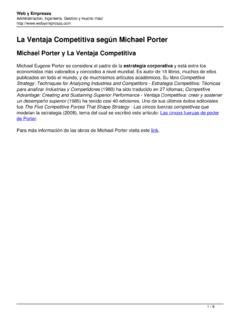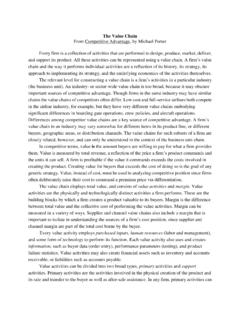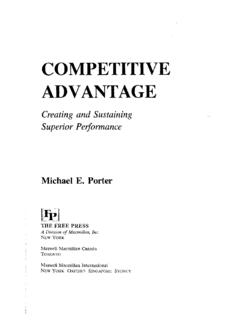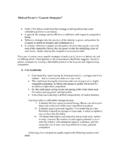Transcription of The Competitive Advantage of Nations
1 The Competitive Advantageof NationsMichael E. PorterHarvard Business Review90211 HBRMARCH APRIL 1990 The Competitive Advantage of NationsMichael E. PorterNational prosperity is created, not inherited. It doesof the patterns of Competitive success in ten leadingtrading Nations , contradict the conventional wisdomnot grow out of a country's natural endowments, itslabor pool, its interest rates, or its currency's value,that guides the thinking of many companies and na-tional governments and that is pervasive today inas classical economics nation's competitiveness depends on the capacitythe United States.
2 (For more about the study, see theinsert Patterns of National Competitive Success. )of its industry to innovate and upgrade. Companiesgain Advantage against the world's best competitorsAccording to prevailing thinking, labor costs, inter-est rates, exchange rates, and economies of scale arebecause of pressure and challenge. They benefit fromhaving strong domestic rivals, aggressive home-basedthe most potent determinants of competitiveness. Incompanies, the words of the day are merger, alliance,suppliers, and demanding local a world of increasingly global competition, na-strategic partnerships, collaboration, and suprana-tional globalization.
3 Managers are pressing for moretions have become more, not less, important. As thebasis of competition has shifted more and more togovernment support for particular industries. Amonggovernments, there is a growing tendency to experi-the creation and assimilation of knowledge, the roleof the nation has grown. Competitive Advantage isment with various policies intended to promote na-tional competitiveness from efforts to managecreated and sustained through a highly localized pro-cess. Differences in national values, culture, eco-exchange rates to new measures to manage trade topolicies to relax antitrust which usually end upnomic structures, institutions, and histories allcontribute to Competitive success.
4 There are striking only undermining it. (See the insert What Is Na-tional Competitiveness? )differences in the patterns of competitiveness inevery country; no nation can or will be competitiveThese approaches, now much in favor in bothcompanies and governments, are flawed. They funda-in every or even most industries. Ultimately, nationssucceed in particular industries because their homementally misperceive the true sources of competi-tive Advantage . Pursuing them, with all their short-environment is the most forward-looking, dynamic,and appeal, will virtually guarantee that the UnitedStates or any other advanced nation neverThese conclusions, the product of a four-year studyachieves real and sustainable Competitive need a new perspective and new tools an ap-Harvard Business School professor michael E.
5 Porter is the authorproach to competitiveness that grows directly out ofofCompetitive Strategy(Free Press, 1980) andCompetitive Ad-an analysis of internationally successful industries,vantage(Free Press, 1985) and will publishThe Competitive Ad-without regard for traditional ideology or current in-vantage of Nations (Free Press) in May fashion. We need to know, very simply,Author's note: michael J. Enright, who served as project coordina-tor for this study, has contributed valuable works and why. Then we need to apply by the President and Fellows of Harvard College.
6 All rights of National Competitive SuccessTo investigate why Nations gain Competitive advan-tries or industry groups for detailed study; we examinedtage in particular industries and the implications formany more in less detail. We went back as far as neces-company strategy and national economies, I conductedsary to understand how and why the industry began ina four-year study of ten important trading Nations : Den-the nation, how it grew, when and why companies frommark, Germany, Italy, Japan, Korea, Singapore, Sweden,the nation developed international Competitive advan-Switzerland, the United Kingdom, and the Unitedtage, and the process by which Competitive advantageStates.
7 I was assisted by a team of more than 30 research-had been either sustained or lost. The resulting caseers, most of whom were natives of and based in thehistories fall short of the work of a good historian innation they studied. The researchers all used the sametheir level of detail, but they do provide insight development of both the industry and the nation'sThree Nations the United States, Japan, and Ger- are the world's leading industrial powers. The We chose a sample of industries for each nation thatother Nations represent a variety of population sizes,represented the most important groups of competitivegovernment policies toward industry, social philoso-industries in the economy.
8 The industries studied ac-phies, geographical sizes, and locations. Together, thecounted for a large share of total exports in each nation:ten Nations accounted for fully 50% of total world ex-more than 20% of total exports in Japan, Germany, andports in 1985, the base year for statistical , for example, and more than 40% in SouthMost previous analyses of national competitivenessKorea. We studied some of the most famous andhave focused on single nation or bilateral comparisons. important international success stories German high-By studying Nations with widely varying characteristicsperformance autos and chemicals, Japanese semi-con-and circumstances, this study sought to separate theductors and VCRs, Swiss banking and pharmaceuticals,fundamental forces underlying national Competitive ad-Italian footwear and textiles, commercial aircraftvantage from the idiosyncratic ones.
9 And motion pictures and some relatively obscure butIn each nation, the study consisted of two parts. The highly Competitive industries South Korean pianos,first identified all industries in which the nation's com-Italian ski boots, and British biscuits. We also added apanies were internationally successful, using availablefew industries because they appeared to be paradoxes:statistical data, supplementary published sources, andJapanese home demand for Western-character typewrit-field interviews.
10 We defined a nation's industry as inter-ers is nearly nonexistent, for example, but Japan holdsnationally successful if itpossessed Competitive advan-a strong export and foreign investment position in thetage relative to the best worldwide We avoided industries that were highly depen-measures of Competitive Advantage , such as reporteddent on natural resources: such industries do not formprofitability, can be misleading. We chose as the bestthe backbone of advanced economies, and the capacityindicators the presence of substantial and sustained ex-to compete in them is more explicable using classicalports to a wide array of other Nations and/or significanttheory.






